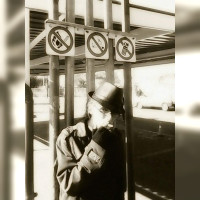Most stories feature many characters. Stephen King’s It (1986) is one example where even briefly-mentioned characters are integral to the story. (You can see its full list of characters on Stephen King’s website.) Think Harry Potter, think Lord of the Rings, think Trainspotting.
But a good story may not need as many characters as you might think. What could you do with fewer characters?
The Best Examples
Start by studying up examples of fiction with five characters or fewer.
Hemingway’s The Old Man and the Sea has only three: The marlin, the old man (Santiago) and the boy (Manolin).
Marlen Haushofer’s The Wall pits an isolated woman against nature, with only a cow, a dog, and a cat to keep her company.
Movies Secret Honor (1984) and Buried (2010) had only one character.
Stories and films like The Girl Who Loved Tom Gordon, I Am Legend, and Gravity (2010) have other characters, but the main character is alone for the bulk of the film.
Isolation
Isolation often plays a part in stories with few characters. Being isolated or trapped is a primal fear, whereas being locked in with someone can be comical or horrifying. (Yes, Cabin Fever is very real and it will have an effect on the way your characters interact with each other and the world.)
Isolation is also a state which squeezes some inner truths out of the character. When no one else can see, what will the character do? What authentic aspects of it will slip out?
Stronger Interactions
With fewer than five characters, there’s a stronger focus on how your characters interact with themselves, with each other, and with their environment.
On a personal level, there might be more of a need for a character’s internal dialogue. A character might become much more self-aware when it is alone. There is no one to divide the attention with.
On an interpersonal level, the relationships become vital and charged. Every word and gesture count. You no longer get the luxury of writing in random passing characters; you need each character to be whole and real and pull its weight in the story.
Other Characters
Other characters, those beyond the story’s main focus, are usually mentioned as a memory or in passing; while they contribute to the story (and are integral parts of your character’s development), they have no need to speak or interact with characters in the present telling of your story.
There are stories which do have more than five characters, but where fewer than five are together for an extended period of the story. What applies to most of this article applies to these, too. For example, think of the first Saw movie, Gravity, or The Martian.
Oh, and remember, animals are characters too!
Pick Your Point of View
POV is important, and it’s likely that internal dialogue is a huge part of your story. What’s going through your character’s minds as your story goes on? How is this relayed to the reader? While the easiest way to convey a character’s inner dialog is the first person POV, don’t go there automatically. Think what other POVs may do for you.
Location and Development
Are your characters stuck in one place, or are they on the move? It’s very hard to keep a reader glued to your plot when you have fewer than five characters stuck in a room.
Moving the characters through different environments may be an easier way to generate variety and new interest for the reader.
Main Characters
When you write a story with many characters, you can afford to introduce a few less-developed characters.
When you write something with fewer characters, that luxury goes out the window. Your characters have to be exceptionally well developed right from the start: their story arc, their motivations, their backstory, their actions, and their thoughts.
You can keep some of these aspects a mystery for the major bulk of the story, but they have to be there in the background, in foreshadowing, and in a large reveal before the end. Otherwise you’ll have a gaping hole in your story.
Making Do with Even Fewer
As if writing a story with only five characters is not enough of a challenge, consider the possibility of your characters getting even fewer. How does the removal of a character change your story arc and the way your characters interact? Many horror classics take a “last character standing” approach to this variant. What could you do with it?
Could you tell a story with fewer than five characters? Do you have a favorite one? Let us know in the comments!




